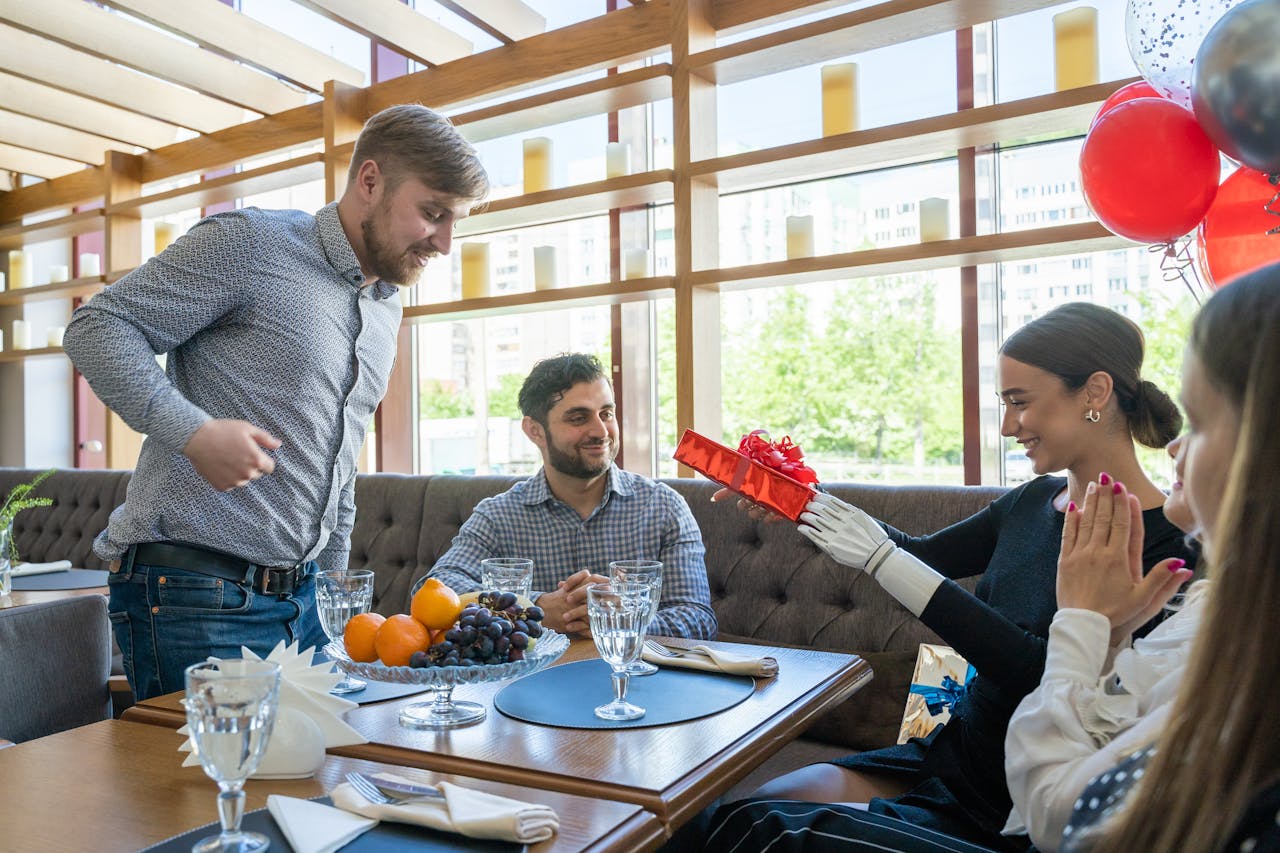Ensuring Customer Satisfaction and Repeat Business: 5 Proven Strategies
Customer satisfaction and repeat business are crucial for long-term success in the restaurant industry. Happy customers become loyal patrons and powerful brand advocates. Providing exceptional service, personalized experiences, and consistently high-quality food and atmosphere are key strategies for ensuring customer satisfaction and encouraging repeat visits.

Happy customers not only become loyal patrons but also serve as powerful brand advocates, spreading positive word-of-mouth and driving new business. However, with ever-evolving customer expectations and a plethora of dining options, keeping customers satisfied and coming back for more can be a challenge.
Many restaurant owners mistakenly believe that simply offering good food is enough to guarantee customer satisfaction and loyalty. While quality cuisine is undoubtedly important, it's just one piece of the puzzle. Exceptional service, a welcoming atmosphere, personalized experiences, and consistent quality across all touchpoints are equally essential in creating a memorable dining experience that keeps customers returning.
In this blog post, we'll dive into five proven strategies for ensuring customer satisfaction and driving repeat business in the restaurant industry. From leveraging customer data and feedback to crafting loyalty programs that truly resonate, we'll explore actionable insights and real-world examples to help you elevate your restaurant's customer experience and build a loyal following.
1. Deliver Consistently High-Quality Food and Service
At the core of any successful restaurant is a commitment to consistently delivering high-quality food and service. Customers return to establishments they trust to provide a reliably excellent dining experience every time. To achieve this, restaurants must focus on several key areas:

Food Quality: Using fresh, high-quality ingredients is the foundation of great food. Chefs should develop standardized recipes and train kitchen staff to execute them consistently. Regular quality checks, proper food storage and handling, and attention to presentation ensure that every dish meets the restaurant's standards.
Service Excellence: Friendly, attentive, and knowledgeable service can elevate even the most casual dining experience. Restaurant owners should define clear service standards, provide thorough staff training, and regularly assess performance. Emphasizing soft skills like active listening, empathy, and anticipating needs can help staff create personal connections with guests.
Atmosphere: A welcoming, comfortable, and well-maintained dining environment is essential to customer satisfaction. From the decor and lighting to the music and temperature, every element should be carefully considered to create the desired ambiance. Regular cleaning and maintenance, both in the front and back of house, are crucial for presenting a polished image.
Consistency is key in delivering on these fronts. Restaurants must implement systems and processes to ensure that food quality, service excellence, and atmosphere are maintained across every shift, every location, and every customer interaction. By reliably meeting and exceeding expectations, restaurants can foster the trust and confidence that keeps customers coming back.
2. Gather and Act on Customer Feedback
Customer feedback is a goldmine of insights for restaurants looking to improve satisfaction and loyalty. By actively seeking out and responding to customer opinions, restaurants can identify areas for improvement, rectify issues before they escalate, and show customers that their voices are heard and valued.
Post-Dining Surveys: Sending a brief survey via email or text message after a customer's visit is an effective way to gather targeted feedback. Questions should cover all aspects of the experience, from food quality and service to ambiance and overall satisfaction. Offering a small incentive, like a discount on the next visit, can boost response rates.
Online Reviews: Monitoring and responding to reviews on platforms like Yelp, Google, and TripAdvisor is essential for managing your restaurant's online reputation. Promptly addressing negative reviews shows that you take feedback seriously and are committed to making things right. Thanking customers for positive reviews reinforces their satisfaction and encourages them to spread the word.
Social Media: Engaging with customers on social media platforms allows for a more informal, real-time dialogue. Responding to comments and messages, running polls and contests, and sharing user-generated content makes customers feel like valued members of your restaurant's community.
In-Person Interactions: Encouraging managers and staff to casually check in with guests during their visit can yield valuable real-time feedback. Train them to ask open-ended questions, read body language, and proactively address any signs of dissatisfaction.
The key is not just collecting feedback but also acting on it. Regularly analyze feedback data to identify trends and prioritize improvements. Share insights with staff and involve them in brainstorming solutions. Closing the loop with customers by letting them know when you've implemented their suggestions shows that their feedback leads to tangible change.
3. Personalize the Dining Experience
In an era of increasing automation and standardization, personalization is a powerful way to make customers feel valued and build emotional connections with your brand. By tailoring the dining experience to individual preferences and occasions, restaurants can create memorable moments that keep customers coming back.
Leverage Customer Data: Collecting and analyzing customer data from reservations, online orders, loyalty programs, and feedback surveys can yield valuable insights into individual preferences and behaviors. Use this information to personalize communications, recommendations, and rewards. For example, sending a targeted email promoting a new menu item to customers who frequently order similar dishes.
Celebrate Special Occasions: Recognizing and celebrating customers' birthdays, anniversaries, and other milestones shows that you value their patronage beyond just a single transaction. Offering a complimentary dessert, a personalized card, or a special table decoration can make the occasion feel extra special and create a positive emotional association with your restaurant.
Accommodate Dietary Needs: With the rise of food allergies, intolerances, and specific diets like veganism and keto, accommodating diverse dietary needs is more important than ever. Clearly labeling menu items, training staff on ingredient knowledge, and offering customizable options demonstrates a commitment to inclusivity and customer well-being.
Surprise and Delight: Unexpected gestures of appreciation can leave a lasting impression on customers. Surprising a regular with a complimentary appetizer, sending a handwritten thank-you note after a visit, or offering a behind-the-scenes tour of the kitchen are just a few ways to create delightful moments that exceed expectations.
Personalization doesn't have to be grand or costly. Small touches that show you understand and care about your customers as individuals can be just as impactful as grand gestures. The goal is to create a dining experience that feels tailored, memorable, and worthy of repeat visits.
4. Implement a Loyalty Program
Loyalty programs are a tried-and-true method for incentivizing repeat business and rewarding your most valuable customers. By offering exclusive perks, discounts, and experiences, restaurants can make members feel valued and encourage them to choose your establishment over competitors.
Choose the Right Structure: Loyalty programs can take many forms, from points per dollar spent to tiered benefits based on visit frequency. Consider your restaurant's business model, average check size, and customer behavior when designing your program. The goal is to create a system that is easy to understand, rewards desired behavior, and offers value to both the customer and the restaurant.
Offer Meaningful Rewards: Loyalty program rewards should be compelling enough to motivate repeat visits and increased spend. Discounts, free items, priority reservations, and exclusive experiences are all popular options. Consider tiering rewards based on membership level to encourage customers to move up the ranks and deepen their engagement with your brand.
Leverage Technology: Using a digital loyalty platform that integrates with your POS system and allows customers to easily track their progress and redeem rewards is essential for program adoption and engagement. Mobile apps, email communications, and SMS messaging can keep your program top-of-mind and make it easy for customers to participate.
Personalize the Experience: Loyalty programs provide a wealth of customer data that can be used to personalize the member experience. Sending targeted offers based on past purchases, recognizing milestones like membership anniversaries, and offering surprise perks to your most engaged members can make them feel like true VIPs.
Continuously Optimize: Regularly review your loyalty program's performance metrics, such as enrollment rate, redemption rate, and member feedback, to identify areas for improvement. Don't be afraid to experiment with new rewards, partnerships, or promotional campaigns to keep your program fresh and exciting.
A well-designed loyalty program not only incentivizes repeat business but also creates a sense of community and belonging among your most dedicated customers. By making members feel appreciated and rewarded for their patronage, restaurants can foster a deep emotional connection that keeps them coming back for years to come.
5. Continuously Innovate and Improve
In a rapidly evolving industry like restaurants, staying ahead of the curve is essential for long-term success. Continuously innovating your menu, service, and overall experience shows customers that you value their satisfaction and are committed to providing them with the best possible dining experience.
Menu Innovation: Regularly introducing new dishes, seasonal specials, and limited-time offers keeps your menu fresh and exciting for repeat customers. It also allows you to capitalize on emerging food trends, showcase local ingredients, and test new concepts. Soliciting customer feedback and involving them in menu development, such as through social media polls or tasting events, can create a sense of investment and anticipation.
Service Innovation: Exploring new ways to enhance the service experience, such as tableside preparations, food and beverage pairings, or interactive elements like build-your-own dishes, can create memorable moments that differentiate your restaurant. Investing in staff training and development, such as sommelier certifications or culinary workshops, can also elevate the level of service and expertise you provide.
Technology Integration: Embracing technology to streamline operations, enhance convenience, and personalize the dining experience can be a major differentiator. Online reservations, mobile ordering and payment, and digital loyalty programs are just a few examples of how restaurants can leverage technology to improve the customer experience. As new tools and platforms emerge, staying open to innovation can help you stay ahead of customer expectations.
Continuous Improvement: Regularly assessing your restaurant's performance across all areas, from food quality and service to cleanliness and atmosphere, is essential for identifying opportunities for improvement. Setting measurable goals, tracking progress, and celebrating wins can create a culture of continuous improvement that permeates every aspect of your operation.
Innovation doesn't always require grand, sweeping changes. Often, it's the small, incremental improvements that add up to a significantly enhanced customer experience over time. By staying attuned to customer needs and industry trends, and being willing to experiment and adapt, restaurants can stay relevant and compelling in an ever-changing landscape.
Conclusion
Ensuring customer satisfaction and repeat business in the restaurant industry requires a multifaceted approach that goes beyond just serving great food. By consistently delivering high-quality cuisine and service, actively seeking and acting on customer feedback, personalizing the dining experience, implementing a compelling loyalty program, and continuously innovating, restaurants can create a customer experience that truly stands out.
Ultimately, the key to success lies in putting the customer at the center of every decision and action. By genuinely caring about their needs, preferences, and feedback, and going above and beyond to exceed their expectations, restaurants can foster the kind of loyalty and advocacy that drives long-term success.
Implementing these strategies requires a commitment from every level of the organization, from ownership and management to front-line staff. It also requires a willingness to invest time, resources, and effort into understanding and adapting to evolving customer needs and industry trends.
However, the payoff of a satisfied, loyal customer base is well worth the investment. Repeat customers not only provide a steady stream of revenue but also serve as powerful brand ambassadors, spreading positive word-of-mouth and helping to attract new business.
In a world where consumers have more dining options than ever before, creating a customer experience that truly stands out is essential for long-term success. By focusing on these five proven strategies, restaurants can create the kind of memorable, personalized experiences that keep customers coming back again and again.







